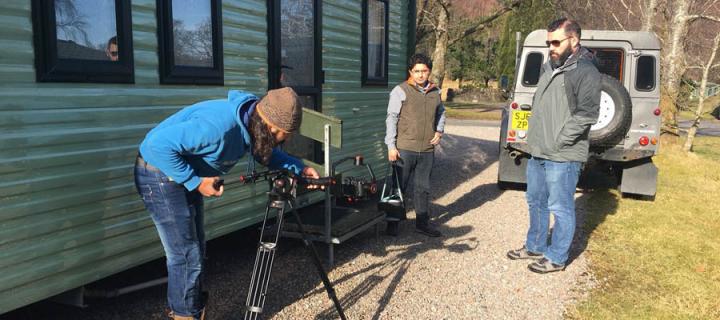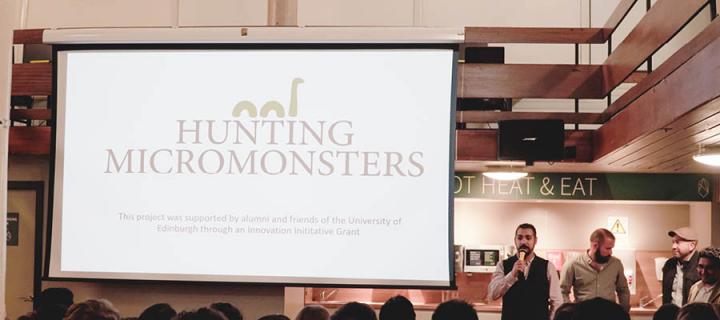Hunting MicroMonsters
Alumni funding has enabled PhD students to travel deep inside the Scottish Highlands to study microorganisms in two lochs and produce a documentary.
A discovery

The idea to hunt micromonsters was born during a weekend trip to Glenfinnan when Samuel Casasola, a PhD candidate in Molecular Plant Sciences within the School of Biological Sciences, collected a sediment samples from Loch Shiel. Alvaro de Obeso, a PhD candidate in Biomedical Sciences whose research focuses on microbiology, then studied the samples and identified a completely new species of amoeba (a single-celled organism that constantly changes shape).
After this discovery, the pair, joined by PhD Student Efraín Zarazúa, who studies Molecular and Structural Biology, and filmmaker Vicente Noviello, saw the opportunities in undertaking more structured research and deeper analysis of microbial life in the lochs, while filming it all.
Lab in the Highlands
This idea became a reality after the team received an alumni-funded grant. In March 2018 the students set off on a five-day expedition to hunt micromonsters in the Highlands.
Water and sediment samples were taken from, Loch Lomond and Loch Ness. The team set up a temporary lab in a caravan in Glen Nevis. They ‘hunted’ during the day and processed the samples in the evening, while documenting it all on camera.
Sampling at Loch Lomond went without a hitch but getting sediment samples from the rocky shores of Loch Ness proved more difficult. They succeeded nevertheless.
To classify the species found in these waters, the group analysed the DNA found in the samples using a method called metagenomics. Metagenomics is the recovery of genetic material, otherwise also called genome. The group first isolated all the DNA from the samples, then they read the DNA sequence and finally compared the type and number of found genes with those available in known genome databases. This allowed them to see what organisms live in the two lochs.
Challenges

While the group had solid lab experience in molecular biology and microbiology, Samuel pointed out that they lacked much experience in metagenomics. To remedy this, the team conducted in-depth theoretical research and practical training before the expedition.
They also sought advice from researchers and other PhD students at the University and ran a training session, during which they collected and studied samples from a pond near campus. So despite the initial lack of experience, they managed to collect enough DNA material and analyse it successfully.
We wanted our project to have solid scientific foundations. To achieve this, we read many scientific publications and compiled a broad collection of protocols about the experiments we were going to do.
The conditions in the temporary lab were another challenge, as highlighted in the group’s online expedition blog:
Minus 6 ˚C in the camping site. 0 ˚C inside the caravan. Pipes frozen. No water, shower or coffee for us today.
Results and potential impact
The group travelled over 1,200km in five days and, as of February 2019, they have characterised the microorganism communities living in Loch Ness. They identified over 2,500 species and have a rough idea of the frequency of these species in the loch. They also found over 100,000 proteins.
The microorganism that were discovered during the ‘hunt’ are active in constant cold temperatures and, as Alvaro suggests in the documentary, this has potentially important industrial applications.
The documentary

The group recorded several hours of footage and have converted it into a 17-minute documentary, now available online. Its title, ‘Hunting Micromonsters’, came from the mysticism around Loch Ness and the legend of its mysterious monster.
The documentary’s premiere was held in December and the venue was packed with curious students and staff. According to Efraín, some filmgoers claimed that if they had seen the documentary earlier in their studies, they would have gone into biology.
Supporting the student experience
The alumni-funded grant of £4,000 helped to pay for the logistics of the expedition and part of the film’s production costs. The support also gave a strong sense of validity to the project and helped them to secure funding from other sources.
The team hopes that the documentary can set an example for similar projects involving science communication.
We liked the idea that the University’s graduates promote and fund students’ ideas. Student Experience Grants help to materialise new ideas which can be the beginning of more significant projects and innovations.
What’s next?
The group has gathered genetic information about a large number of microorganisms and proteins, but they still have a lot of data to analyse further to better understand the samples they have collected.
They would also love to see more people involved in the Hunting MicroMonsters project. There has even been talk of building a new platform to encourage other students to hunt micromonsters in lochs, and fostering a community to share information and compile a database. It seems that a sequel documentary is not off the table either.
Related links
Hunting MicroMonsters (external link)

